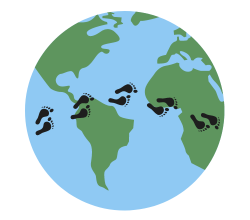When I was in university, I applied to work at a local deli as a summer job. They called me out of the blue for a phone interview. One of the questions was whether I’d be comfortable slicing meat. As a vegetarian, I wasn’t sure how to answer. I hadn’t thought about this question before or considered that aspect of the job when applying. I hedged and, needless to say, never heard back from them.
I later decided that it probably would have been all right since the customers would order meat regardless of whether it was me or somebody else working there. It was more a matter of whether I was comfortable physically handling meat.
The situation got me thinking about the environmental ethics of employment and how your sustainability values translate into the work environment.
In this post, I dive into how to be sustainable at work. The information is more geared towards office workers. However, some of the tips should also apply to people working in different industries and types of jobs.
The extent to which you can make efforts to be sustainable at work depends on things like your industry and line of work, how committed your employer is to sustainability, how secure your job is, and how well you get along with your manager and team. Not everyone can work in a green job or influence their company’s procurement practices and other environmental decisions. Nonetheless, the workplace is one of our largest areas of influence, along with family and friends, and every bit helps.
How to get started on being sustainable at work
There are two main ways to be sustainable at work: working in a “green” job and promoting sustainable practices at your workplace. The majority of this post focuses on possible sustainable practices to promote, whether individually or as part of a green team. Before getting started, here’s some information about working in a green job and launching and running a green team.
Work in a green job

If you’re able to and motivated to make sustainability your life’s work, you could consider working for a “green” employer like an environmental non-profit, a purpose-driven business, or a government agency or research institute focused on the environment. These types of jobs don’t need to look like being out in nature identifying wildlife or speaking into a megaphone as an activist (though they might). These green employers also need people working in a variety of areas, including finance, operations and marketing.
To find a green job in Canada, try using the job board GoodWork.ca and consulting the resources available through ECO Canada and Project Learning Tree Canada.
Even if you don’t work directly in a green job, think about what products or services your company offers and how it operates. Are you comfortable with the organization’s impact on the planet and approach to sustainability? To find companies that are thinking carefully about their social and environmental impact, check the directory of B Corps.
Start or join a green team

Regardless of where your employer is at environmentally, there’s always more to be done. That’s where green teams come in. A green team is a group of staff members who care about environmental issues and want to promote sustainability at their workplace—like a school environment club, but for adults. Often, you can effect more change when working in a group than when advocating on your own.
The David Suzuki Foundation has helpful tips for starting a workplace green team. These include things like building a team with representatives from different departments and senior management, meeting regularly, setting goals and making an action plan. I would say that it’s also important to communicate regularly with other staff to keep them informed about your organization’s green initiatives.
If you’re wondering what actions to start with, check out my tips below or Living Planet @ Work. This free program from WWF-Canada offers resources and ideas for workplace sustainability.
Suggestions for workplace sustainability actions
There are many sustainable practices that you can promote at work. I’ve broken them down into different categories below. I’d suggest picking one or two actions to start instead of trying to tackle everything at once.
Waste reduction
From recycling initiatives to reducing paper use, waste reduction is one of the easiest areas for getting started on workplace sustainability. Here are some waste reduction actions you can try at work:
- Start a collection of reusable containers, glasses, mugs and cutlery to encourage staff to ditch the disposables.
- Install recycling stations in common areas with clear signs about what goes where.
- Set up a composting system for collecting food waste.
- Work with an electronic waste recycling company to responsibly dispose of e-waste like laptops and cell phones.
- Encourage staff to think before they print and adjust printer settings to reduce paper use.
- Run waste-free meetings and events by using reusable dishes and supplies, ordering smaller quantities of catering and making a plan for what to do with any leftovers.
Energy conservation
Energy conservation behaviours reduce the amount of energy used. These efforts are amplified if you also use energy-efficient devices. Here are some energy-related actions you can try at work:
- Turn off the lights in rooms that are not in use and at the end of the workday. This is made easier by using lighting controls like motion sensors and timers.
- Switch to LED light bulbs and use other energy-efficient devices.
- To cut down on phantom energy, avoid leaving devices on standby or plugged in unnecessarily.
- Make sure computers are turned off at the end of the day.
- Set the temperature a bit warmer in the summer and cooler in the winter to reduce energy use from cooling and heating.
Water conservation
Similar to energy conservation, water conservation uses water efficiently and reduces water waste. Here are some water-saving actions you can try at work:
- Install water-efficient devices like dual-flush toilets and flow regulators on taps.
- Collect rainwater using a rain barrel.
- Reduce the number of dishwasher loads by only running the dishwasher when it’s full.
Nature and biodiversity
Nature and biodiversity-related actions allow staff to enjoy time outside while improving the health of the environment. Here are some nature-focused actions you can try at work:
- Start a vegetable and herb garden.
- Plant wildflowers and native plants to attract pollinators.
- Install homes for animals like birdhouses and insect hotels.
- If you don’t have access to an outdoor space, get indoor plants to improve staff well-being.
- Give back to the community by participating in clean-ups and tree planting days.
Commuting and travel
The way that staff members get to work can greatly contribute to the environmental impact of their workday. If staff travel for work (particularly by air), that also adds to the organization’s carbon footprint. Here are some transportation-related actions you can try at work:
- Encourage staff to walk or bike to work. This includes ensuring adequate cycling infrastructure, like secure bike racks and showers.
- Offer staff incentives to take public transit, like discounted transit passes.
- Set up a carpooling program for staff members who live near each other.
- Encourage the use of video calls instead of travelling for meetings.
- Where possible, take the train or bus instead of flying.
- When flying, look for flights with fewer carbon emissions. This includes flying non-stop where possible.
Digital pollution
One of the most significant forms of pollution is invisible. Online activities, including sending emails, sharing documents, having video calls and doing internet searches have a surprising environmental impact. Here are some actions you can promote to reduce digital pollution at work:
- Send fewer emails and don’t hit “reply all” unless it’s really necessary.
- Delete old emails and documents.
- Unsubscribe from newsletters you don’t want.
- Send links to documents instead of attachments.
- Keep your camera turned off in video calls.
- Have fewer tabs open.
- Stream videos and audio in lower quality.
How to be sustainable at work
As I hope you can see, there are many options for being sustainable at work, just like in your personal life. By joining a team of like-minded employees and choosing one or two areas to make a difference, you can start to raise awareness, promote sustainable habits and make your workplace more sustainable.
I want to know: Have you advocated for sustainable practices at work? What has your experience been?
Categories and tags:
Share this post:

